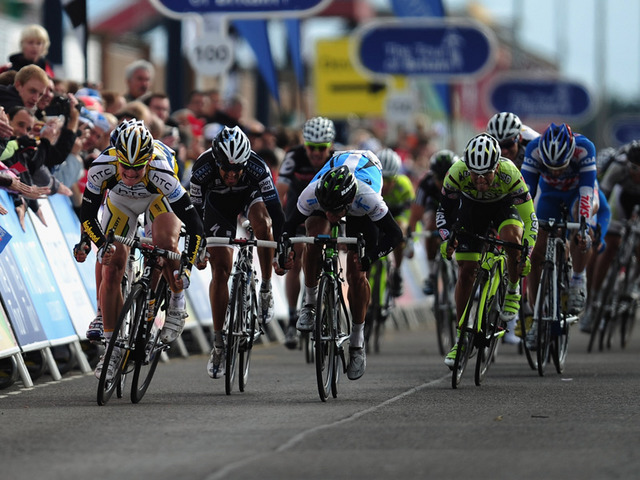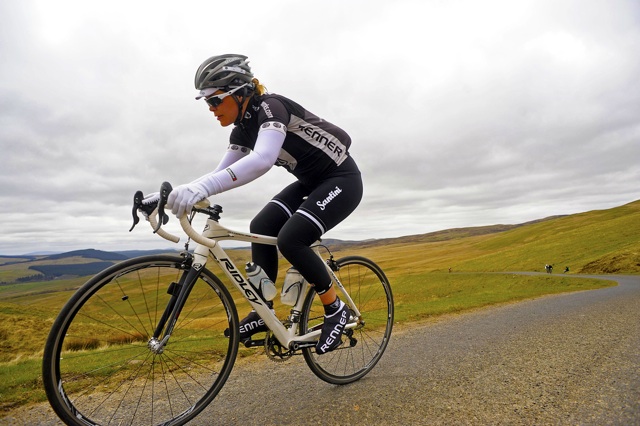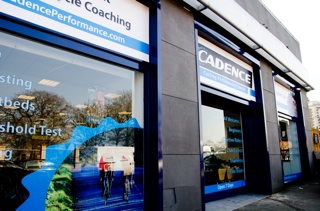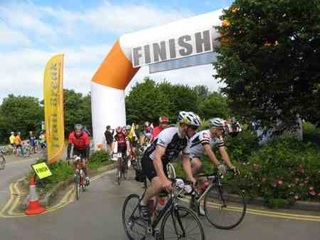Fitness training for cycling has become increasingly scientific.
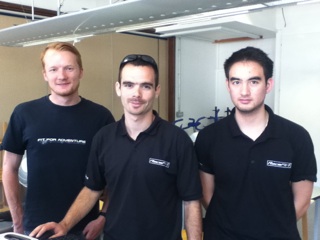
The V02 Max test, one that discerns the maximum capacity of an individual to transport and use oxygen, is a popular method by which to establish a base measurement of fitness.
Such tests are typically packaged with analysis of blood lactate (the level at which it occurs), maximum heart rate, and measurement of body mass. The results provide a foundation for a training programme.
My day with Racefit at Oxford Brookes University begins with coach, Tom Kirk, taking my measurements, including height, weight, and skin fold (a diplomatic term for flab). Measured, and marked with a biro, I put my jersey back on and climb aboard the static bike, a machine on which resistance can be increased incrementally and measured in watts.
The first test of the day is a step test, beginning at 100 watts and increasing in 25 watt increments to 225 watts. Tom hands me a breathing tube while a member of his team periodically pricks the index finger of my left hand to collect samples for blood lactate analysis.
I’m told to target a cadence of around 90rpm throughout, but as the resistance increases, ironically, so do my revolutions, and by the end of the test, I’m spinning at just over 100rpm to produce 225 watts. Aside from power, cadence, and blood lactate, Tom’s report records my physiological response to the increased resistance in six other categories, ranging from the obvious (heart rate) to the intriguing.
Ventilation signifies the total amount of air I’m able to process through my lungs. The V02 of the title indicates the volume of oxygen used, while the VCO2 reading records the amount of carbon dioxide expelled. RER is the ratio of oxygen used to carbon dioxide expelled, and indicates whether fat of carbohydrates are being used for fuel. Economy is the crucial measure: the efficiency with which energy is converted into power on the bike.
After recovering from this 20 minute test, I face another, shorter exercise: the ramp test. This is more brutal. My task is simple: to keep pedaling while the resistance is increased at a relentless 25 watts a minute until I can no longer maintain a cadence of 90rpm. I focus hard, but as the watts get higher and higher I am unable to keep up, despite the encouragement of Tom and his team and the expenditure of every last ounce of energy. It’s an exercise that takes the rider to exhaustion.
More interesting data emerges. The maximal ramp test, to give it its full title, reveals a rider’s maximum aerobic power output and the aforementioned V02 max (here measured as the peak average). A V02 max reading it transpires is not an absolute value that can be used to make a direct comparison of fitness between riders. It’s measured in the litres of oxygen used by the rider each minute. It follows then that the V02 max reading varies with body size. “An equally aerobically fit 60kg cyclist will have a lower absolute V02 max than an 80kg rider,” says Tom. His report includes two values for V02 max: the absolute value and V02 max relative to body weight.
While not a heavy rider, I still “have room to lose some body fat,” Tom reports, an outcome he says that would improve my peak power to weight ratio, a valuable commodity for tackling the short steep climbs in the UK, some of which we can expect to see in the forthcoming Tour of Britain.
Functional Threshold Power represents a rider’s sustainable power output, and is perhaps the most useful measure for improving performance. Tom describes FTP as “the intensity you can maintain for a long time trial.” It’s a measure gained from the step test, and it’s now that I understand the need for the constant pin pricks to the index finger. After the first increase in watts, my blood lactate increased. It rose steadily in line with the resistance before making a big jump at 200 watts or 158bpm.
The amount of watts per kilo of body mass a rider is able to produce at their FTP is the key measure of a racing cyclist’s performance. A male pro cyclist will have an FTP of five to six watts per kilo, say Tom; a Tour contender something like 6.5 watts per kilo! Mine? Well, let’s just say I’m not expecting any phone calls from Dave Brailsford. Better news lies in my V02 max readings which Tom says indicates that concentrated endurance training could increase my FTP by 20 per cent.
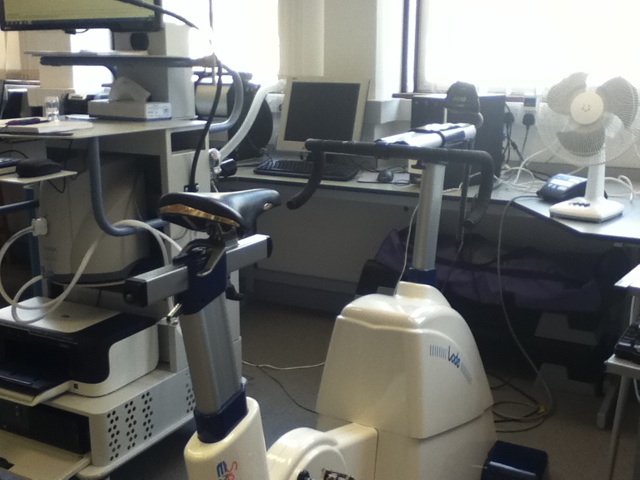
‘Gas exchange’ sounds like the measure for the potency of a pre-test curry, but instead determines the proportion of fat and carbohydrates burned as fuel. The results were revealing. My body used fat as fuel up to 125 watts, but at higher outputs, particularly those over my lactate threshold, carbohydrate became the key fuel source. “This is because carbohydrate is the only fuel that can be used for anaerobic metabolism,” says Tom. Once I’d reached my FTP, carbohydrate became my body’s sole source of fuel. Not only is this data interesting for its own sake (many of the gym machines I’ve used indicated a ‘fat burning zone’ at the highest intensity) but an extremely useful guide for on the bike fueling, if riding with a heart rate monitor.
The results of the tests allowed Tom to create a table of six training zones, based on power and heart rates. Zone one, for example, for recovery or social rides, has a ceiling of 110 watts or 120bpm.
For zone two, the values are only slightly higher. Rides in this zone will target fat oxidization (burning), but Tom warns “large volumes of training at this intensity are necessary for training effects to be evident.”
Zone three represents the typical intensity demanded by a long race. While lactate increases at this level, the body is able to metabolise it, keeping levels steady. Tom says that prolonged training sessions at this level are possible, but warns that they must be adequately fuelled by carbohydrate, adding that while consecutive training sessions are possible at this level, recovery will take longer than from sessions at zone two.
Training at zone four is sustainable only for about an hour, says Tom. “This training zone is both physically and mentally taxing,” he warns, and best performed in long intervals of up to half-an-hour. The body cannot ‘buffer’ the lactate produced and so it will continue to rise, and with it, fatigue. Carbohydrate will be the fuel source at this level.
Zone five is ominously labeled ‘above threshold training’, the type of efforts Tom says typically last between three and eight minutes. The rider should be well rested before attempting such efforts, he says, and sufficient recovery time allowed afterwards. The benefits? V02 max (the litres of oxygen used by the rider each minute ) will be improved as well as the rider’s ability on short climbs.
Somewhat to my relief, the letters ‘NA’ appear on my chart in the column for zone six, efforts designed to take the rider to their capacity for anaerobic efforts.
I leave Oxford Brookes University tired but enlightened and looking forward to Tom’s report. The bulk of his findings have been discussed above, and the summary isn’t entirely dispiriting.
I have a good V02 max, which could be further improved with high intensity training. My FTP occurred at 81 per cent of my V02 max, and by increasing this I will improve my sustainable speed. Tom recommends long efforts at heart rate/power zone three or the lower end of zone four, alongside endurance rides that will improve my base fitness and boost my lactate threshold.
My top end power can be increased by efforts at my V02 Max pace and higher, says Tom, but he recommends focusing on improving sustainable power. “Your V02max suggests you have good potential but are not making the most of this capacity,” he concludes.
The offer of customized training plan is made, but the advice Tom has offered on the day and in his report has give me plenty to consider. Used in conjunction with my Garmin 500 and my heart rate monitor, I’m looking forward to more focused rides and hopefully improved sustainable speed.

